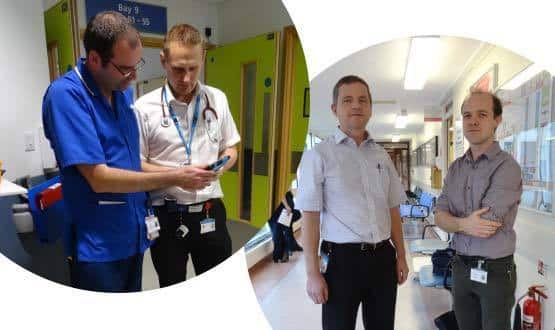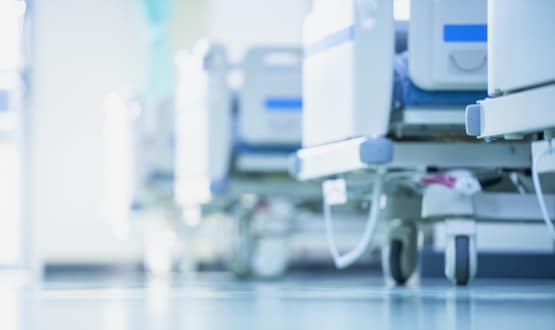Tracking down kidney failure: Western Sussex develops AKI alerts
- 28 January 2016

Hannah Prince, the outreach lead for Worthing Hospital, looks alarmed as an overview of patients with sepsis is pulled up on a computer screen. “Wow,” she says, “that’s a lot of patients. Normally, there would only be four or five. It’s really busy out there today.”
Here is the NEWS
The overview is being generated from Patientrack, which Western Sussex Hospitals NHS Foundation Trust has been using since 2012.
At its simplest, Patientrack enables doctors, nurses and other clinical staff to electronically record observations at the bedside, that are then used to calculate National Early Warning Scores, or NEWS.
Richard Venn, a consultant in anaesthesia and intensive care, and the lead clinician for the development and implementation of the system at the trust, says it was initially used to identify and locate deteriorating patients.
But more recently, a lot of work has gone into using the system to pick up patients with specific problems, such as sepsis and acute kidney injury.
“Before we had this system, I could come in on a weekend and I would not know where patients were,” Venn recalls. “I would not know which patients were deteriorating, perhaps until an arrest call went out. So that was the driver to deploy this.”
Worthing started with a pilot of Patientrack in its admissions unit, but is now using the system across its ‘emergency floor’.
This, in itself, is a £6.5 million innovation, developed with the Royal College of Physicians, to provide multi-disciplinary team care for the majority of patients due to be admitted to the hospital, including the frail elderly.
Patientrack has also been rolled out to all the wards at the trust’s two main hospitals, but not yet to its A&E, maternity or paediatric services, for which different scoring is needed.
Venn says it is hard to disassociate its effects of the IT system from other initiatives, including the outreach team, the emergency floor, and safety campaigns.
But in combination he says they have led to a change in culture. “Now, if you ring a ward to say they have a deteriorating patient, they usually say: ‘Yes, we know, we are dealing with it’,” he says.
Bufalo charge on sepsis
Patientrack has also been used to support a big campaign on sepsis. Medical staff are encouraged to consider whether patients could be at risk of sepsis, and if they are Patientrack prompts them to undertake certain interventions.
Collectively, these have the acronym BUFALO: blood cultures, urine output, fluids, antibiotics, lactate and oxygen. The campaign has clearly taken off; there are bright red BUFALO posters on hospital walls and a surprising number of staff are wearing BUFALO badges on their uniforms.
However, Venn says cheerfully: “We pinched BUFALO from Bradford [Teaching Hospitals NHS Foundation Trust] – I must acknowledge them, or they’d be cross.”
Bradford, like Western Sussex Hospitals, is part of a group of foundation trusts called QUEST that is committed to improving patient safety, and which exchange ideas and tools with each other.
While Worthing has picked up ideas from Bradford on sepsis, it is doing its own work on AKI in collaboration with researchers from Southampton University and with Patientrack.
A use of a different kidney
Luke Hodgson, an intensive care and respiratory medicine research fellow, explains that AKI is a big cause of mortality – “in hospital, one fifth of patients die, and within a year of being in hospital, 60% die” – and a major cost to the NHS – “about £1 billion a year is spent on it.”
Yet, despite the development of NICE guidelines, patients with failing kidneys are not always spotted early or well managed. One problem is that a common test for kidney failure is how much of a muscle waste product called creatinine is not being dealt with by the kidneys and is being accumulated in the blood.
“By the time creatinine levels start to rise, there is already damage,” says Hodgson. “So we came up a model that combines what the [blood test] number is doing with facts about the patient and their medical history to risk stratify the likelihood of them developing kidney injury.”
In IT terms, this means taking some information, such as the patient’s age, from the patient administration system, and putting it together with information from pathology and observations taken on Patientrack to come up with a red, amber, green rating.
“It sounds quite simple, but in technical terms it is quite complex,” says Hodgson. He is now undertaking an impact assessment of the new system by comparing Worthing’s performance on AKI with that of another of the trust’s hospitals in Chichester, which has yet to roll it out.
Experience on the wards
The AKI project may have involved a lot of complex medical research and IT development, but on the emergency floor of Worthing General, the presentation of data from Patientrack does, indeed, look simple.
Dr Adrian Richardson, a specialty doctor/geriatrician, shows how he can sit at a computer terminal and pull up a list of patients with their NEWS, sepsis and AKI scores by ward or consultant, or filter by RAG rating.
He says this is useful during the staff ‘huddle’ that starts the day and during ward rounds, because “we can talk to the junior doctors, and when they get to the wards they can go straight to the sickest patients” and “do everything possible to keep them well.”
His colleague, nurse in charge Paul Murphy, says nurses are “completely on board with the system” because it helps with the management of both wards and individual patients.
“It is very useful because we can come onto the ward and get a list of how patients are and how nurses are managing their time. If the observations are late being made, then people will not be managing for whatever reason, and we can address that.
“With the NEWS score, you can really tell who needs review. So, today, I had a patient at nine, and I was on the phone to outreach, but Sarah [one of the outreach team] was already on her way.”
This, of course, is the other side of the outreach team looking at the screen and seeing patients they need to get to. Prince explains that they will review patients with a NEWS score of seven or more, and her colleague Zoe Blair says Patientrack makes this much easier.
“Before we had this system, we used to put stickers in the notes of patients [whose vital signs would have been recorded on paper, and whose NEWS scores would have been added up manually],” she says.
“Then, I would go to the wards and ask if there were any patients who needed review. Now, we can just look at the overview.” On AKI, specifically, she adds: “We can pick up these patients, whereas before we would not have known where they were, or that they had a problem.”
Challenges
The system may be working well now, but there were challenges in rolling it out. Robert Clacher, the acting director of IM&T, says “this was the first, big clinical project” for the trust, and it threw up all sorts of issues.
Infrastructure, for example, required considerable attention. Even today, the Patientrack team is cautious about rolling out ‘push’ alerts to ward staff because different devices, from pagers to mobile phones, work and don’t work in different parts of the hospital.
A pilot project, to email NEWS score alerts to mobile phones carried by ward sisters, is just about to start. But devices were another issue. Clacher and Venn both shake their heads at the memory of the handheld devices they started out with four years ago.
“They were just not sophisticated enough,” Clacher says. “You could walk from one end of a ward to the other, and they would drop [the wireless connection] and you would have to restart.”
The trust is now using a combination of iDevices and ‘bring your own device’; and its next big challenge is integration.
The Patientrack team has plenty of ideas for extending the system; from using it to generate fluid charts, to picking up cases of dementia, to using it to assess frailty – a big issue on the south coast, with its elderly and often poor population.
But it also wants more integration with more of the trust’s core systems, starting with a new e-prescribing system from JAC, its pharmacy supplier.
This will add another dimension to the NEWS score and other alert lists, since clinicians will be able to see whether drug interventions – such as prescribing antibiotics for patients with sepsis – have been completed, without going into another system.
New plans
Western Sussex Hospitals’ predecessor, Worthing and Southlands Hospital NHS Trust, was one of the first in the South to receive an electronic patient record system from the National Programme for IT; and the first to switch one off.
It reverted to its old Sema-Helix system after a merger with its neighbour, Royal West Sussex NHS Trust, which had never adopted Cerner Millennium, and is still using it.
The trust’s IT strategy now envisages retaining the PAS, but giving clinicians access to other systems via a clinical portal from Kainos, which will also supply a document management system.
As such, the trust is taking an unusual route to digitisation; starting with the patient observations and alerts that many trusts put ‘on top’ of a PAS and other core systems, and working back into them; with the aim of achieving an electronic patient record in about three years.
Donald Kennedy, managing director of Patientrack, says: “In every hospital, there will be a remarkable number of systems, with more or less overlap between them.
“As a supplier, you have to accept that there will be differences, and fit in with that. The key thing is to get the NHS and SMEs [small and medium sized enterprises] working closely together.”
Everybody involved with the Patientrack roll-out seems to feel this has happened. “They have been there when we have needed them, but they have not forced us to do things their way,” says Clacher. “It’s a very friendly relationship.”
Backed by the board
Everybody involved in the roll-out also agrees that board level support has been key, not least because this has freed up the necessary funding; in part through keen attention to developments that will generate commissioning for quality and innovation payments.
Marianne Griffiths, the chief executive of Western Sussex Hospitals, says her aim has been to “make the right thing to do the easy thing to do.” And, while she also stresses that it’s hard to pick IT’s contribution out of the initiatives that it drives and supports, she also says the whole package has paid off.
“When we started, our HSMR [hospital standardised mortality ratio] was 108 [well above what would be expected]. Now, it is 90.4 which, for a trust of our kind – with multiple sites – and with our patient profile – an average age of 85 – is terrific,” she says.
“From a board perspective, this is paying off. We are seeing an improvement in quality and in other things, such as patient feedback. If you get results like that, I don’t think it is difficult to keep the board on side.”




